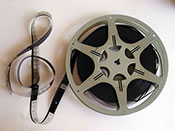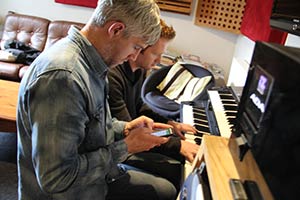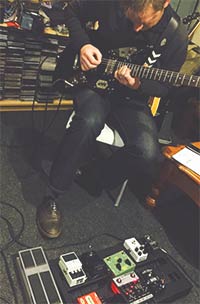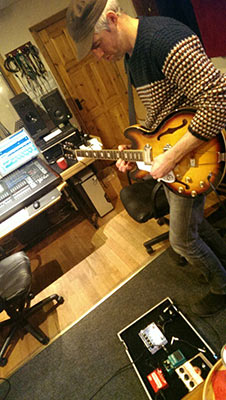Interview with Three Machines

Recording the Celtic Tenors with producer Charles Fisher

Music Licencing & Sync


Q. You are no stranger to the studio but this was your first time producing your music . What gave you the confidence to take the reigns? Its getting a lot of praise for its Production and sonics!

Kieran: Yes, this was my first time producing. I think that yes, the concept was originally daunting but it was born out of necessity I feel, in that I needed to sculpt things, to coexist with every aspect of these songs as they developed. I knew where I wanted to go this time round but also I have many years working with Martin and I have a very good working relationship and I feel quite comfortable with him.
Q. What are the challenges you faced this time in writing, arranging and producing?
Kieran:There were many continuous challenges with writing, arranging and producing. I might answer that in segments.
The writing: I suppose writing is always difficult mainly because it sets the visual picture for me, so essentially once I have written something, I start to see aspects of the finished creation so it becomes quite real from an early stage. Some of the problems I encountered was I was writing a lot at home with no home recording facility, just a phone, a guitar, some sound samples and a notebook, so it was quite primitive and that can be difficult in developing ideas at times. Also when I meet Eamonn and Ian, sometimes those ideas were hard to translate. Other times I'd Ian or Eamonn might send me one or two ideas and I'd retreat to my spare room and work on them. I did hit a wall half way through the ablum. I'd finished writing six or seven songs and just couldn't progress any further. It took nearly a month to mount that creative hurdle but thankfully it worked out.
Arranging: I understand that there are some formulaic concepts to arranging but I placed a lot of emphasis on responding to the natural feel of the songs, especially when considering, sonic textures, intensities, mood, rhythms, overall objectives etc. I suppose I wanted the arrangements to be individual from track to track while maintaining a cohesiveness across the record and I think some tracks came together faster than others. It was difficult when certain arrangements just didn't work with songs, that whole 'back to the drawing board' can be disheartening at times.
Producing: Producing, for me, was where I could sculpt the vision to a proper state. I found the producing role intense and there were times where I questioned myself at times but we got to where we needed to go.
Martin: Kieran did a fantastic job of having a singleminded vision of what he wanted and didnt want. This kicked things on immensely! Theres nothing worse than a non decision maker in music production! Thats when the session really slows down!
Q. Trying to get ideas and sounds from your head and into the recorded world can be quite a challenge. Was the process frustrating or relieving?
Kieran This is always a challenge. I think that in the last year Martin has come to have a greater understanding of how my brain works. Martin: I'll never understand your brain Kieran! Kieran: (laughs) Martin helps a non technical person like myself translate precisely what I am looking for from my head to the recorded sound. With lots of working together we found our own way to communicate and understand each other. There was a lot of fun and laughter in the studio!
Q. Your writing and arrangement method is methodical but fragmented. Can you tell us about how the songs and arrangements for Forsaken came about?
Kieran: I felt that the album should be taken as a piece in itself and that the tracks should not necessarily be taken as individual pieces. I wrote song titles before some songs were written. I also had the track-listing formulated before other songs were written. This was a conscious attempt to create a musical work that consisted of ten tracks. Every aspect of the making of this album was premeditated. The arrangements nearly grew with the songs themselves. I would nearly always obsess over aspects of the songs until such time as I could feel, see or hear what the arrangement should be or where the song should go.
Q. It had been a while since you played drums in your first band Doris. But you undertook it yourself. Drumming in studio is hard when your measured against the click! How was it being back in the seat... or on the stool more accurately? 
Kieran: I had drummed a little in the early days of White McKenzie but essentially it had been several years since I had been behind a kit. The problem was was that I had virtually no drum practice and no facility or time to do so either. So, going into a studio to drum to track with no practise and being extremely rusty was always a little stressful but I wanted to drum. I felt that I knew what the songs needed. I wanted to involve the drums more in serving each track from an arrangement sense.span class="ArticleTextFirstLetter">Martin:Kieran is a very musical and stylistic drummer and always plays for the song. I love drummers that when you hear a song on radio you can say 'I know who played drums on that', Kierans drum tracks always did that for me!
Q. .. and you were after a particular drum sound? How did you get there?
Kieran: I wanted that dead '70's drum sound with those warm full sounding toms. That in itself might sound like a contradiction but Martin understands it. Martin: Kieran showed me referenced of very claustrophobic sounding drum sounds with little room ambience akin to a compressed 70's drum feel. The Black Beauty snare was tuned right down to its limited and deadened. Acoustic screens were brought close around the kit. In order to maintain options later in the arrangement and aid control over the sounds we also recorded certain parts of the kit in isolation (kick and snare on one performance, hi hat overdub, tom tom overdub etc..)
Q. ‘Forsaken’ was recorded all during the time you were filming for Love/Hate. Did Love/Hate influence the music in any way? Its very filmesque.
 Kieran:Love/Hate definitely influenced some of the writing on the album but no, it didn't influence the sound in any way. Stuarts very specific about the music he selects for Love/Hate. I tried to nitride him to Sigur Ros once, I think he'd lean more towards the Pixies and Led Zeppelin. Martin: It was amazing to watch Kieran juggle phonecalls from all facets of his life and still be focused on the music. Before one of the last sessions he came in shattered after spending most of the night lying in a field, acting for the short movie 'Little Bear', but still gave everything to the recording session.
Kieran:Love/Hate definitely influenced some of the writing on the album but no, it didn't influence the sound in any way. Stuarts very specific about the music he selects for Love/Hate. I tried to nitride him to Sigur Ros once, I think he'd lean more towards the Pixies and Led Zeppelin. Martin: It was amazing to watch Kieran juggle phonecalls from all facets of his life and still be focused on the music. Before one of the last sessions he came in shattered after spending most of the night lying in a field, acting for the short movie 'Little Bear', but still gave everything to the recording session.
Q. Sonically you chose to revisit a lot of the same instruments from song to song. Piano, French Horn, Strings, Haunting reverbed backing vocals and dry compressed drums. A conscious choice?
Kieran: Definitely. I felt that this would help with the bands identity and also I felt that it would aid the notion of correlating songs as well as inciting creativity in keeping the songs and arrangements interesting and individual.
Q. And you took your time... 'Forsaken' was recorded across a period of how long?
Kieran: It was recorded over about 12 months finishing in January 2015.
Q. Ian Corr’s piano seems to be a centrepoint of the album holding things together. How does this work between you?

Kieran: Yes, from the outset of this project i decided that piano should have a significant presence throughout the bands music, and I suppose it sets the stall to a degree for the direction of the band. I think that with White McKenzie the piano wasn't always welcome on some of the heavier, grungier tracks, but we consciously decided for it to be a primary feature with Hail The Ghost. I think piano in even it's most simplistic form can speak volumes in a song. Ian is a wonderful player.
 Q.
I know you poured over the guitar tones with Eamon Young and Martin @ JAM quite a bit. What were the guitars and pedals you kept coming back to on this record?
Q.
I know you poured over the guitar tones with Eamon Young and Martin @ JAM quite a bit. What were the guitars and pedals you kept coming back to on this record?
Kieran: For the atmospherics and ambient roles, Eamonn would have used a Fender Jagaur, generally played through a Fender Twin amp. A lot of the atmospherics were captured using variations of reverbs, delays, ebows volume swells etc. Some of the more characterised guitar lines were played on one of two hollow body guitars, Eamonns Gretsch or Martins DeArmond. Most of the rhythms were recorded on one of Martin's vintage Fender Telecasters and mainly through the Fender Twin amp. Martin: For the more distorted guitar tones we did use several overdrive pedals which included: the Boss Bluesdriver, the T-Rex Moller, Full Metal Jacket and a Line 6 DM4
Q. You recorded some guitar yourself too?
Kieran: I recorded a little electric guitar on 'Nostalgia' and 'Ink & Blood' and the acoustic guitar on 'Drift'. That was nice to do. 
Q. Were you tempted to replace them with the real thing?
Kieran: Budget is always an issue but the amazing sample libraries at the studio meant that I never felt the need to look outside that. Martin: French horn is featured heavily and the CineBrass sample library happens to have an amazingly realistic French horn! We also used the LA Strings library for string stuff. We had options open to bring in players or use the Prague FILMHarmonic orchestra remotely but decided we were happy with the samples. They didnt cheapen the production because of how they were integrated in the arrangements.
Q. The album opener starts with footstomps. These are your feet on the floor we hear?.... and the clocks in Lazise?
Kieran:Yeah, those feet are myself and Ian in studio. The clocks are two samples blended together which Martin quite brilliantly did.
Q. Reverb plays a big part in the sound of Hail the Ghost. Where does that come from and what reverbs were used? Whats going on behind your vocals sometimes? Is it whispers or something else?
Kieran: Reverb does play a large part on this album and I've come to really appreciate it's worth in recording and in sound. Martin: We used a lot of Plate and Spring reverbs on this album. The best virtual plate reverb in the world today is probably UAD EMT140 plate, and thats what we used. I also really like the plugin 'Springage' and the UAD Roland RE201, both of which were used a lot. There were also times that we used the Valhalla Room and Shimmer reverb plugins for modern digital reverbs as well as the studio hardware TC M3000. Guitar wise we found ourselves returning to the Electro Harmonix Cathedral reverb pedal. As regards the backing vocals, I recorded some pushed whispery type vocals and on some tracks I dropped the level to nearly a talking line which in isolation sounds like a thwarted grumble but masked by the lead vocal it can add a lovely edgy texture to overall vocal sound.
Q. How did you approach the mix process?
Kieran: We actually mixed as we went, constantly refining the songs. This proved invaluable for a few reasons. I feel that with this process we were always nurturing the track as it developed and that it afforded us the opportunity of making informed decisions at any stage because we continually had a current appreciation of what the track was at any specific stage of the process but most importantly it meant that there was literally tidying up to do at the end of the album and not a mammoth task of beginning to mix a years worth of recordings. Martin:This was an unusual request from Kieran that we would often begin sessions by going back over older songs to make sometimes very small mix tweaks. It was nice to have songs 'in the bag' so that the final mix process wasn't so intensive, as it normally can be when your faced with 12 big mixes to do!
Q. And for Mastering…?
Kieran: With mastering myself and Martin took a collection of songs that we feel represented both the dark undertones of the record and the grand cinematic vibe and we used them as references or gauges to pitch the album against.
Click here to find out more about Hail the Ghost
The album "Forsaken" is available in the iTunes store and most other digital download mediums. Its also available in CD format at HMV


